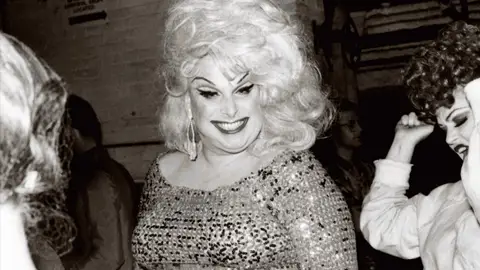The World's First Gay TV Program: "The Emerald City"

It’s wild to imagine that over 40 years ago there was a gay TV program that had news reports, club performances, and in-depth interviews with writers, porn stars, film directors, and others from all walks of life. It was called The Emerald City and it was dubbed in The New York Times as “the world's first television show for gay men and women.”
First produced in 1976, The Emerald City spoke to prominent gay figures like John Waters, David Hockney, and Larry Kramer. It aired on a leased access channel where Eugene B. Stavis, Frank O'Dowd, and Steven Bie bought airtime and sold advertising time. What began in New York City, was soon available to gay people in San Francisco and Los Angeles, before The Emerald City ceased production in 1978. Today, it lives on in the corners of YouTube as a fascinating time capsule for a golden age of gay life.
Stavis, the executive producer, and O’Dowd, the writer-director, have since passed away. O’Dowd’s ex-lover, Bie, who is still in New York, was a producer on the show and also handled its advertising and marketing. Legendary porn director Wakefield Poole and actor Ken Kliban helped interview guests (Poole was also interviewed himself). The three, along with cabaret singer Selma Hazouri, who was featured on the show, talked to NewNowNext about what it meant to be a part of the world's first gay television program in the '70s.
The Beginnings
Wakefield Poole: Frank was into TV production and was very much a gay activist and it just happened. It’s like I made my movies. It just happened. They got it together and, you know, they were talking and Gene said, well, “I’ll produce it and we’ll do it.”
Steven Bie: Public lease was a new type of thing and nobody knew what to do with it. The Emerald City was one of the first—not only the fact of being gay—[to use] cable and what they used to call... narrowcasting—[because] you were being very targeted.
Ken Kilban: It was [Stavis’] brainchild and Frank was a friend of his and I was a friend of his, so he broached the subject to me. He knew I was an actor, so I gave [interviewing] a try. I mean, it was the first time I’d ever interviewed anyone, certainly on film, and it was a little amateurish, but it was okay.
A Reflection of the (Gay) Times
Bie: Gay people were coming out and it was about building up culture and also making money. You know, that you could actually create a high-quality product and make money selling advertisements and that was the goal.
Poole:We were very happy to have a gay television show emanate from New York, and a platform to put ideas out there and what life was really like to be gay.
Bie: The big selling point of the show was this idea of going into cabarets and going to locations because you have this portability of this three-quarter inch cassette.
Selma Hazouri: It was also one of the few places, in any time, in any venue, whether it was paid print or TV or anything, that featured cabaret.
Bie: The work that these people were doing in cabarets would never have been taped or recorded by anyone. There’s stuff on Divine for the Neon Woman.
Building a Following
Poole: The people started talking about it, and [Stavis] got bigger and bigger people to come on because it was such a wide scope, a wide variety. You didn’t have to be gay to be on the show but, you know, a lot of gays love Cher and I’m sure if Cher had been around she would’ve probably done one.
Bie: It was really pretty glamorous, pretty exciting to have this level of people and just a lot of people who were pretty big in their careers and not minding just saying matter of fact that they were gay. It was more about celebrating their careers.
Kilban: I think it was a liberating and elevating and enlightening experience. It was... a cultural event. It really had very little to do with sex.
Bie: It was fun and it was exciting. There was also a sense that [there was] going to be a great new world for gay people, and also, it was New York really coming around. So I think it was about being New Yorkers, it was about the excitement of the energy that was in New York in the ‘70s. It was really quite a wonderful time.





